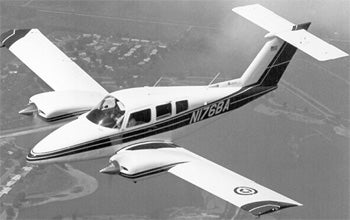 |
| STANDARD DATA: Seats 4. Gross wt. 3,900. Empty wt. 2,460. Fuel capacity 100. Engine two 180-hp Lycomings. PERFORMANCE: Top mph 197. Cruise mph 191. Stall mph 69. Initial climb rate 1,248. Ceiling 19,650. Range 717. Takeoff distance (50) 2,119. Landing distance (50') 1,881. |
This low-priced twin is fitted with two 180-hp Lycoming engines and is designed to carry four people with 180 pounds of luggage and optional equipment at 185 mph for more than 800 miles. The twin includes doors on both sides of the cabin. Optional avionics are similar to those on the Beechcraft Sierra. The Model 76 makes use of honeycomb-bonded wings for a smoother airfoil design with less drag and a lower manufacturing cost. Unlike other Beech twins, it was marketed through the Aero Centers because its economical and easy-to fly operation made it ideal for multi-engine training, charter, and personal transportation.
Outstanding design characteristics of the Duchess include an aerodynamically advantageous T-tail, which places the horizontal surfaces above the propeller slipstream for better stability and handling, and oppositerotating propellers to eliminate the "critical engine" aspect of multi-engine flying. In 1980, a 28-volt electrical system was added to provide increased cranking power in cold weather, more power for avionics, and improved parts commonality with other Beech products. The most recent improvements to the Duchess included a "Throttle Q Switch" that prevents the landing-gear warning horn from sounding when the throttle is retarded if the airspeed is kept above 99 knots; this allowed the pilot to reduce power during descent without having to listen to the gear horn. Also, RCA Weather Scout II radar was available as an option.

Subscribe to Our Newsletter
Get the latest Plane & Pilot Magazine stories delivered directly to your inbox





